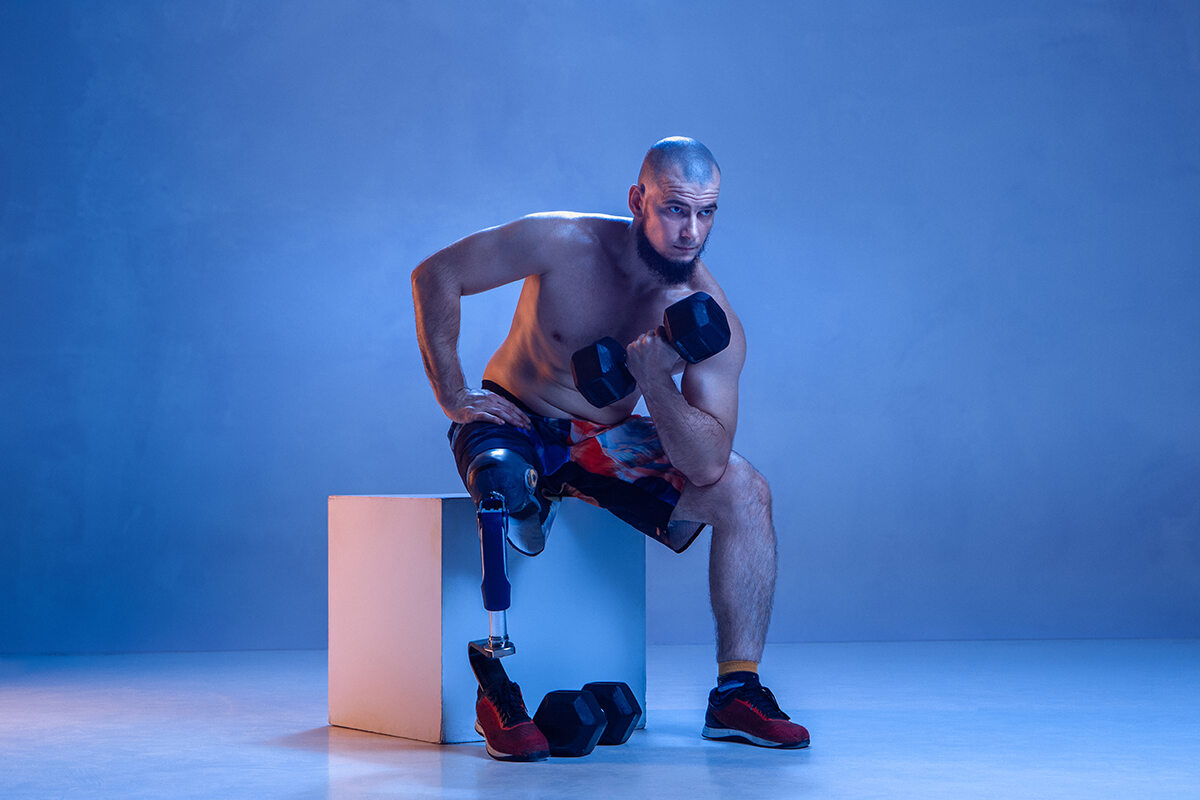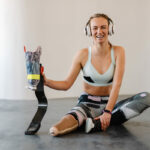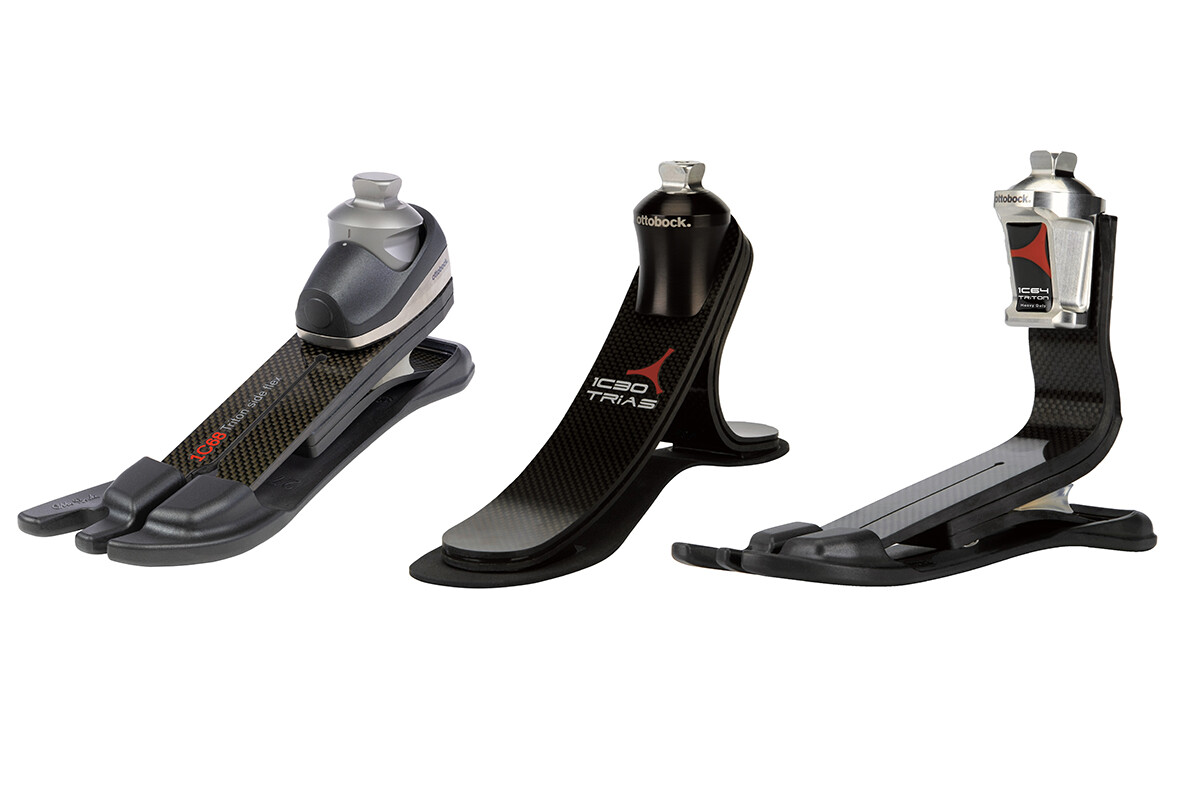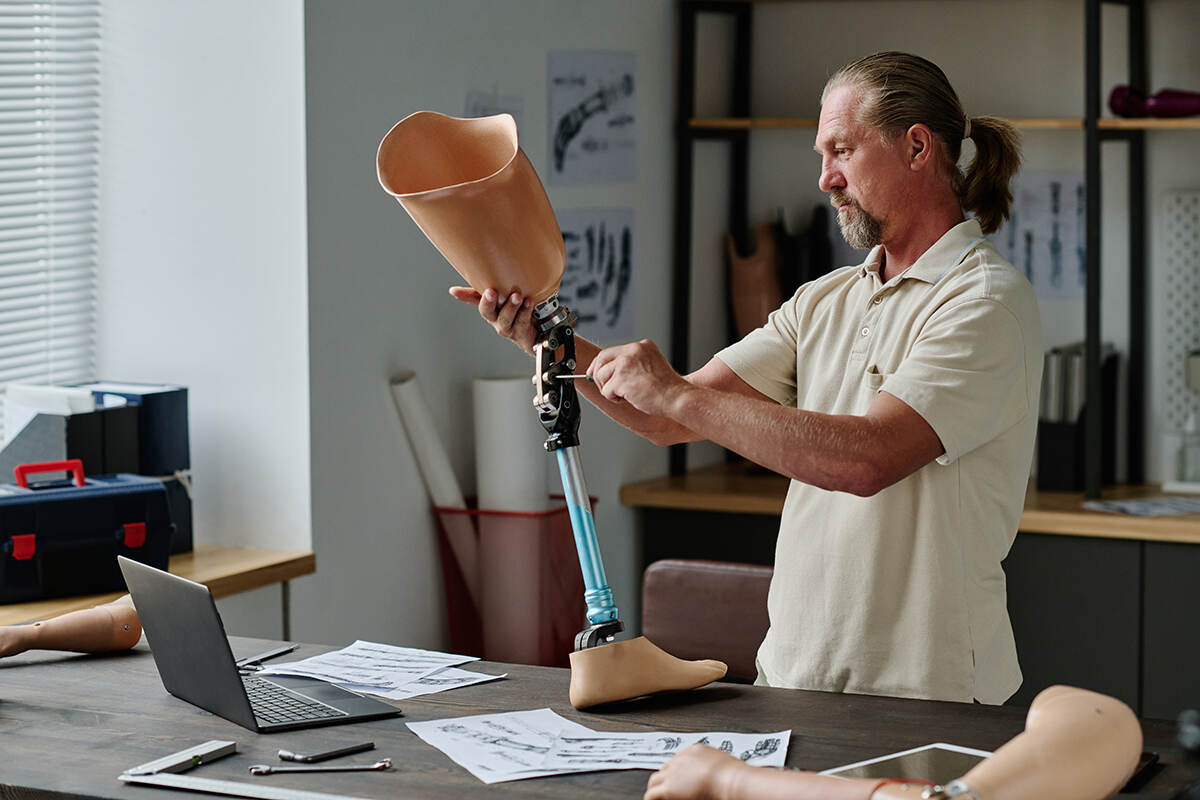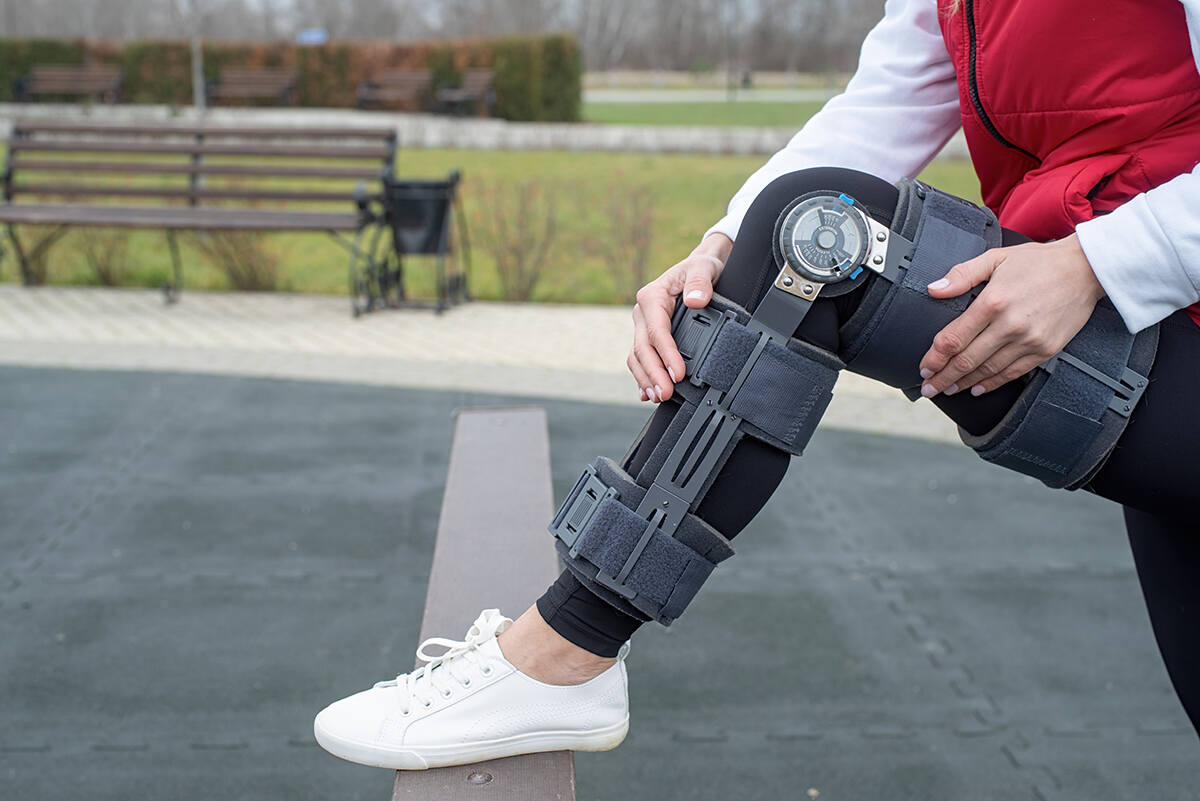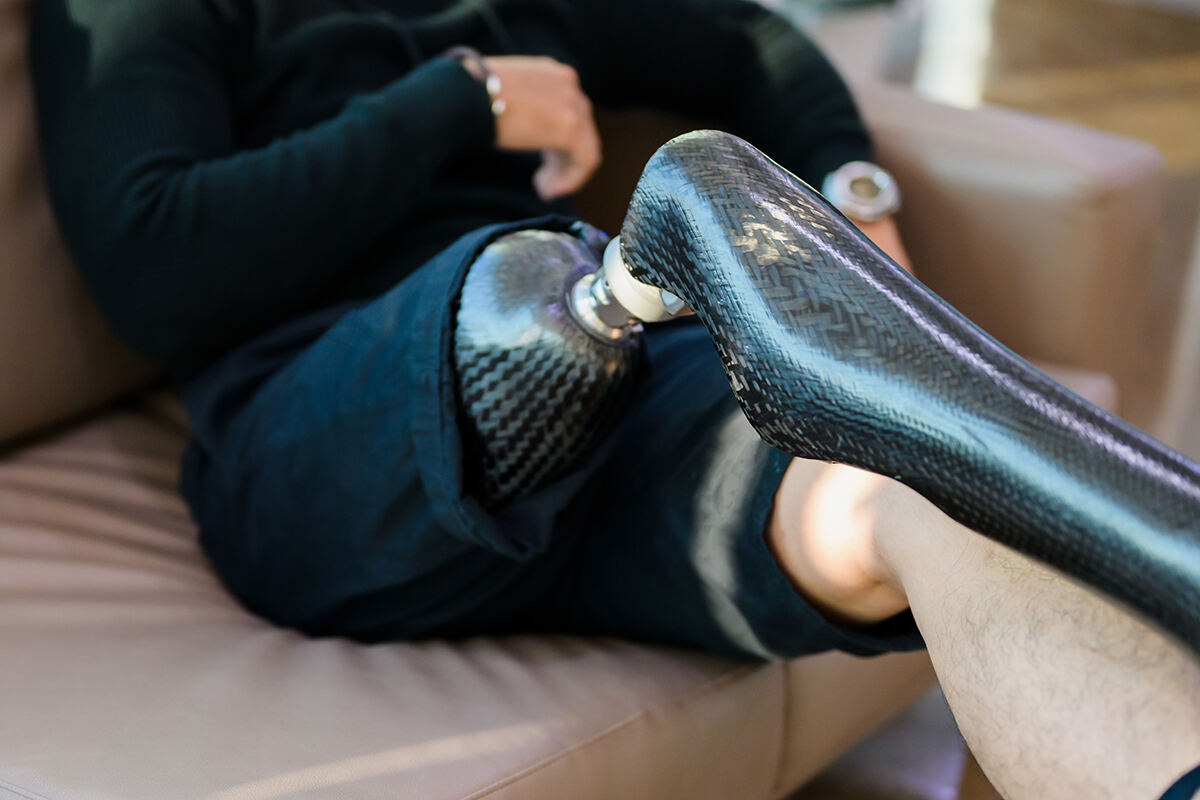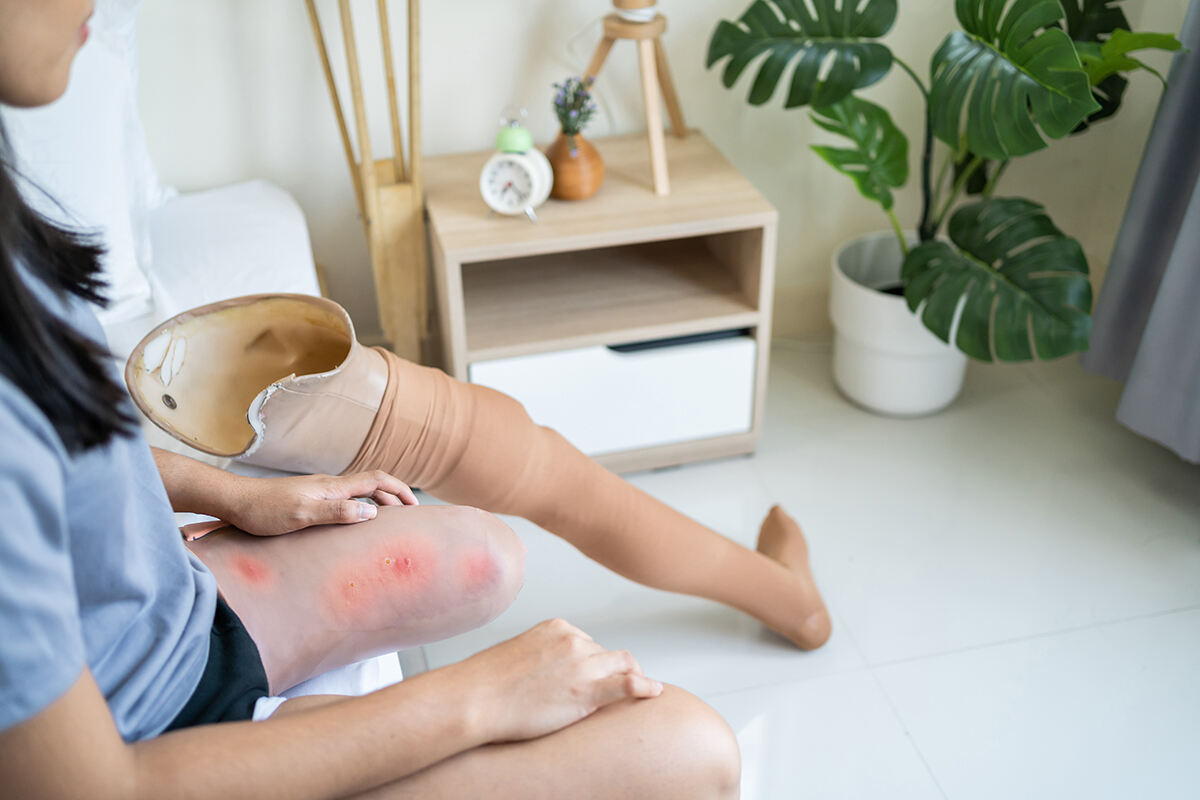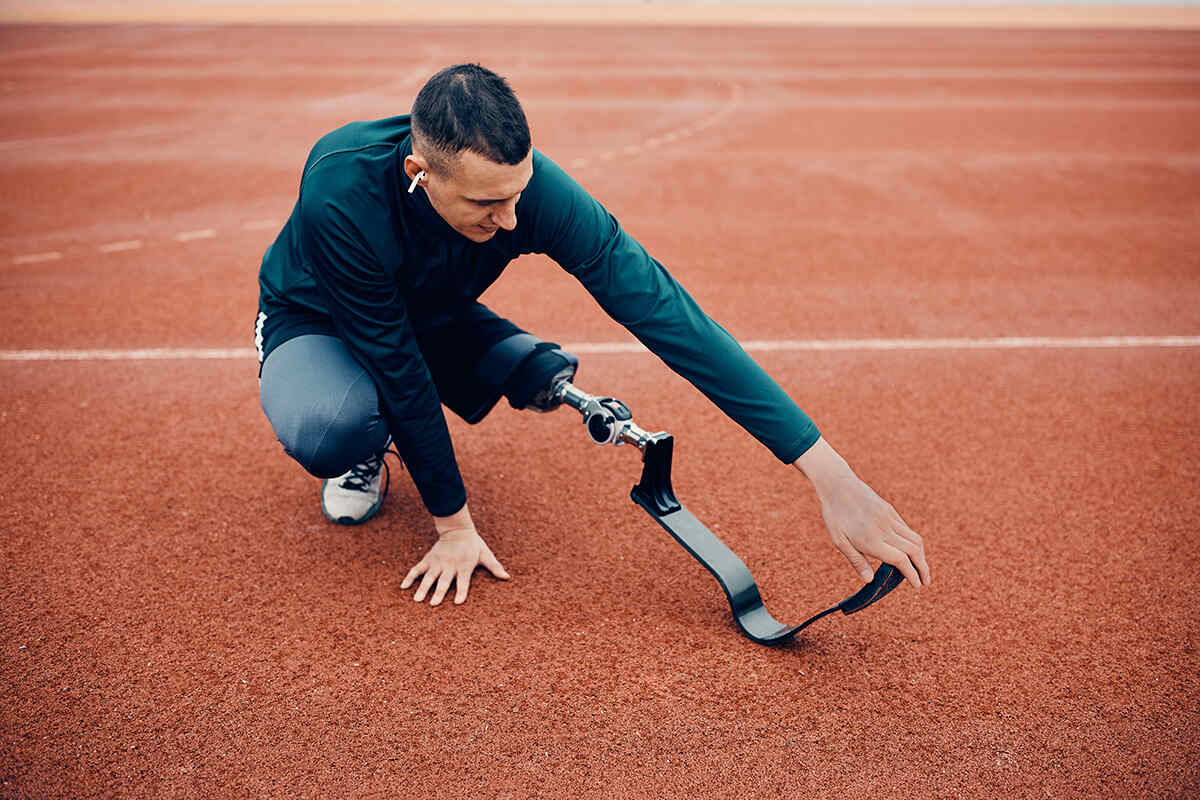Empowerment through exercise is for amputees looking to regain their independence and lead a more fulfilling life. In this blog post, we’ll guide you through some exercises for amputees, designed for various amputation levels, ensuring a safe and effective workout routine that builds strength, enhances mobility, and improves overall fitness.
Key Takeaways
- Exercise is key to a vibrant and fulfilling life for amputees, providing physical & mental benefits.
- Adapted exercises can be tailored to different amputation levels. Focus on building core strength with modified planks, seated Russian twists & leg raises.
- Working with a physical therapist enables customized exercise programs for optimal prosthetic fit and function plus ongoing support & progress monitoring.
The Importance of Exercise for Amputees

Being physically active is not only about fitness for amputees but also a path towards a more vibrant and fulfilling life. Regular exercise provides physical and mental benefits that can significantly alter the manner in which amputees lead their daily lives. Before starting an exercise regimen, verify with a doctor or physical therapist that you’re focusing on suitable areas.
Physical Benefits
Building muscle tone, increasing bone density, and enhancing balance and stability are just a few of the physical benefits that come from regular exercise for amputees. Focusing on exercises that target:
- abdominal muscles
- lumbar muscles
- hip muscles
- shoulder muscles
Regular exercise can help amputees with a residual limb or an amputated limb stay fit and healthy while preventing muscle atrophy.
Mental Benefits
A strong body goes hand in hand with a strong mind. Exercise can work wonders in improving:
- cardiovascular health
- building endurance
- reducing stress levels
- promoting better sleep
- lifting mood for amputees
By committing to a regular exercise routine, amputees can feel more confident in their abilities and enjoy a better quality of life.
Adapting Exercises for Different Amputation Levels
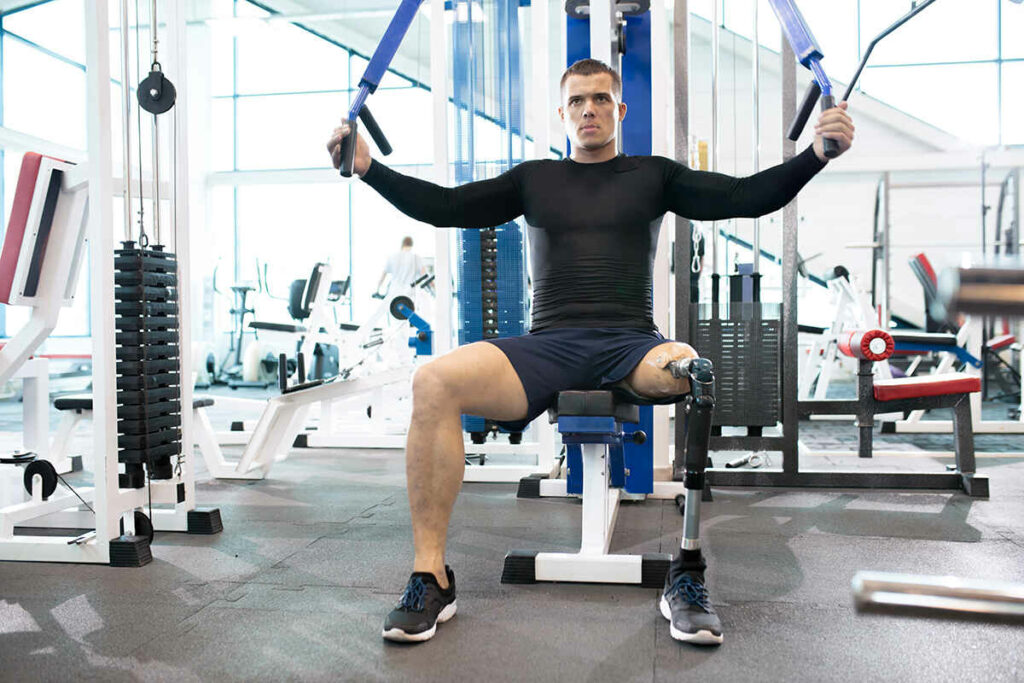
For effective workouts, it’s crucial to modify exercises to match your specific level of amputation. These modifications can involve:
- The use of assistive tools such
- Concentration on exercises that work on the remaining muscles and joints
- Inclusion of exercises that enhance balance and flexibility
Partnering with a healthcare professional or physical therapist can help you develop a personalized exercise plan that maximizes the benefits of your workouts.
Above Knee Amputees
For above knee amputees, focusing on hip and core strength is key to maintaining mobility and overall fitness. Exercises like hip flexor stretches, gluteal sets, and adductor stretches will help you keep your muscles strong and flexible.
Remember, it’s essential to stretch your muscles at the front of your hip regularly to prevent them from becoming tight.
Below Knee Amputees
Below knee amputees, as well as those with an above knee amputation, can benefit from the following workout alterations, which are designed to accommodate the unique challenges of lower extremity amputation, particularly below knee amputation:
- Sitting exercises
- Knee bending exercises
- Unilateral training
- Core strengthening exercises
These adjustments will help you maximize your fitness journey and maintain a strong, healthy body.
Upper Limb Amputees
Concentration on core and lower body exercises is imperative for upper limb amputees. Adapt your workout routines innovatively by using prosthetics or other adaptive tools, focusing on the remaining muscles and joints, and incorporating exercises that enhance balance and flexibility.
Seeking advice from a healthcare professional or physical therapist will ensure the best possible exercise plan tailored to your needs.
Building Core Strength for Amputees
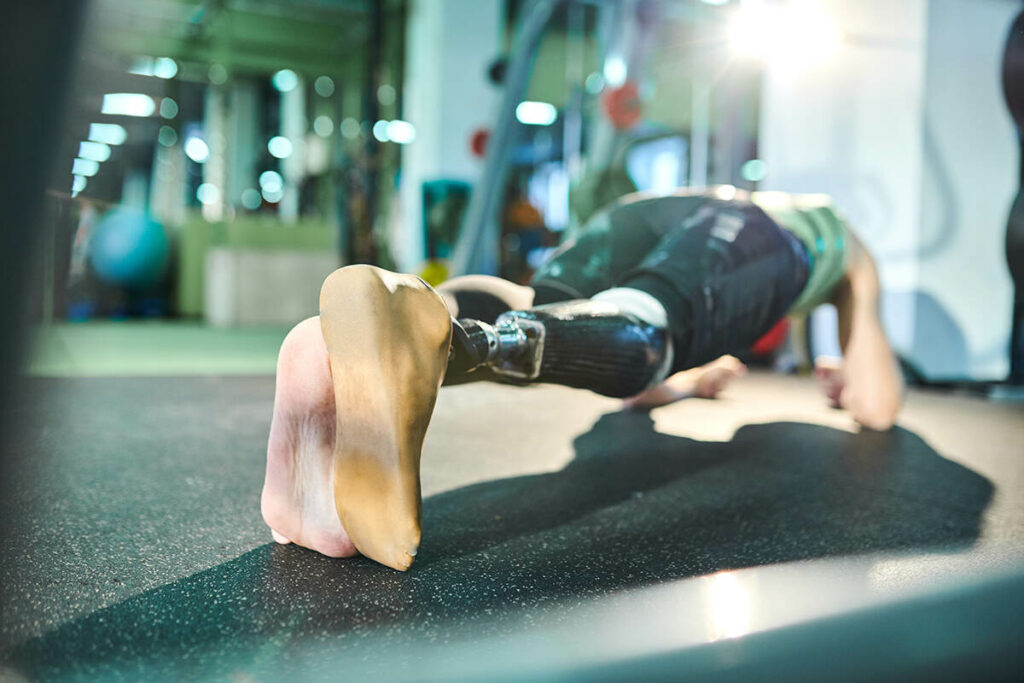
For amputees, a robust core is vital as it offers stability and support for the entire body. Here, we’ll present three core strength exercises tailored for amputees: modified planks, seated Russian twists, and leg raises.
Modified Planks
Modified planks can be performed with a prosthesis or on your knees for added support, depending on your comfort level. This exercise is great for strengthening your core muscles, including your abdominal muscles, back muscles, and the muscles around the pelvis.
Remember to maintain proper form and engage your core throughout the core exercises for maximum benefit. Incorporate the following exercises into your routine to ensure a well-rounded workout.
Seated Russian Twists
Seated Russian twists are a fantastic way to target your oblique muscles and strengthen your core. To perform this exercise:
- Sit on the floor with your legs bent and if possible feet pressing firmly into the ground.
- Hold your arms next to your chest.
- Lean back slightly, keeping your spine straight and core engaged.
Twist your torso to one side until your hands are slightly bent and parallel to the ground, then twist to the other side. You can perform this exercise with or without added weight, depending on your preference.
Leg Raises
Leg raises are an excellent exercise for amputees that can be performed lying down or seated, depending on your amputation level. This exercise helps strengthen your hip flexors, improving your gait and enhancing your core strength. Be sure to consult your physical therapist for guidance on the best way to perform leg raises for your specific needs.
Strengthening Leg Muscles
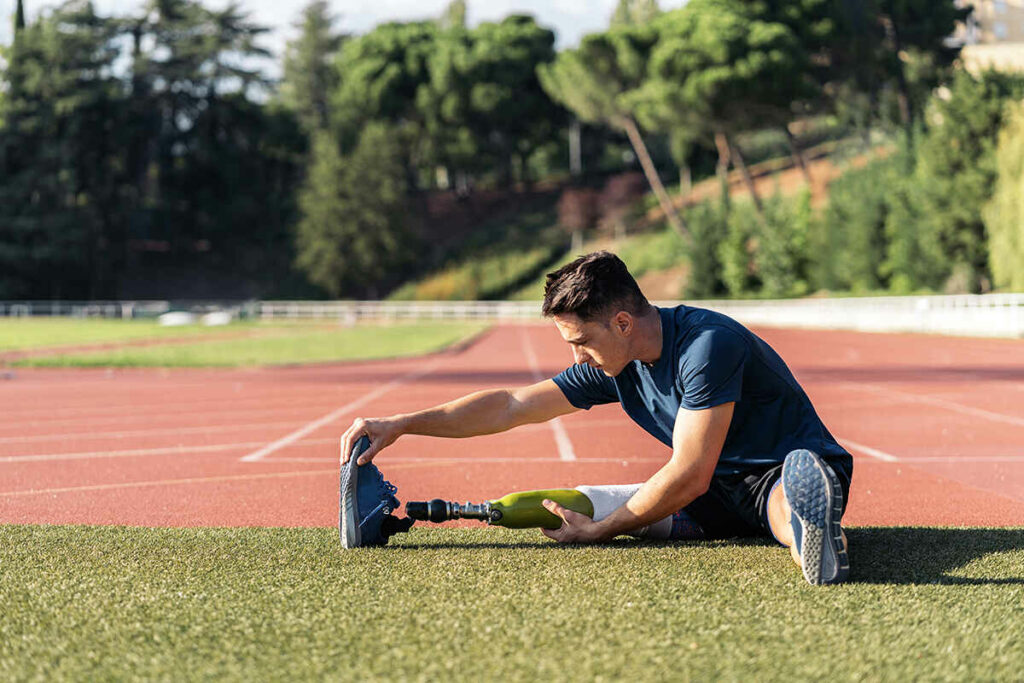
For amputees, developing solid leg muscles is key to preserving mobility and balance. We’ll present three leg-strengthening exercises created for amputees: adapted squats, single leg press, and calf raises.
Adapted Squats
Adapted squats can be performed in different ways:
- With support, such as a wall or chair, to help you maintain balance and stability during the exercise
- Using a resistance band to provide additional support and assistance
- With a stability ball to engage your core muscles and challenge your balance
This leg strengthening exercise targets your quads, hamstrings, glutes, and lower-back muscles, helping you stay strong and active.
Single Leg Press
The single leg press is a fantastic exercise for amputees to focus on an unaffected leg, building strength and stability. This exercise targets your quadriceps, hamstrings, and glutes, ensuring a well-rounded leg workout that helps improve mobility and functional capacity.
Calf Raises
Calf raises are a versatile exercise that can be done with or without a prosthesis, depending on your comfort and balance. This exercise helps to strengthen your calf muscles, improving your walking ability and overall mobility. Remember to start with a comfortable range of motion and gradually increase the intensity and range as you build strength.
Enhancing Upper Body Strength

For amputees, a robust upper body is vital as it offers stability and support for daily tasks. Here, we present three upper body strength exercises specifically tailored for amputees: modified push-ups, resistance band rows, and seated dumbbell press.
Modified Push-Ups
Modified push-ups can be done with your knee straight or on your knees, depending on your comfort level. This exercise is great for strengthening your arms, shoulders, chest, and core muscles, helping you stay strong and active.
Resistance Band Rows
Resistance band rows are a fantastic way to target your back muscles and can be performed seated or standing. This exercise helps to strengthen:
- Lats
- Traps
- Rhomboids
- Biceps
Ensuring a well-rounded upper body workout that helps improve your overall fitness and mobility.
Seated Dumbbell Press
The seated dumbbell press is a great exercise for strengthening your shoulders and can be done with one or both arms, depending on your preference. This exercise targets:
- Anterior delts
- Lateral delts
- Upper trapezius
- Triceps
This ensures a comprehensive shoulder workout that helps improve your overall strength and stability.
Balance and Coordination Training
Enhancing balance and coordination is vital for amputees, aiding in the preservation of mobility and minimizing the risk of falls and injury. We’ll present three balance and coordination exercises specifically designed for amputees: single leg stands, stability ball exercises, and modified yoga poses.
Single Leg Stands
Single leg stands are a fantastic way to improve your balance and can be done with or without a prosthesis, depending on your comfort level. This exercise helps to:
- Strengthen your leg muscles
- Improve your overall balance
- Ensure a well-rounded workout
- Improve your mobility and functional capacity.
Stability Ball Exercises
Stability ball exercises are a great way to challenge your balance and core strength. These exercises can be adapted for different amputation levels and can help to improve your overall fitness and mobility.
Some great stability ball exercises for amputees include ball-rolling exercises for standing posture and balance, basic crunches, planks, chair crunches, bridge, and supermans.
Modified Yoga Poses
Modified yoga poses can be a fantastic way to improve your flexibility and balance, as well as promote overall well-being and stress reduction. Some great modified yoga poses for amputees include:
- The Cat Pose
- The Eagle Pose
- Hip Stretch
- Forward Bend
- The Twist
- Leg Stretch
These poses can be adapted to suit your specific needs and abilities, ensuring a safe and effective yoga practice.
Stretching and Flexibility
Sustaining flexibility and range of motion is crucial to minimize muscle tension and enhance overall physical function. Three stretching and flexibility exercises specifically designed for amputees: hamstring stretches, hip flexor stretch, and shoulder and chest stretches.
Hamstring Stretches
Hamstring stretches can be done seated or lying down, using a strap or towel for assistance. This exercise helps to lengthen and stretch the muscles at the back of your leg, improving your overall flexibility and range of motion.
Remember to begin from a comfortable starting position, with a suitable range of motion, and gradually increase the intensity and range as you build flexibility.
Hip Flexor Stretch
The hip flexor stretch targets the front of the hip and can be modified for different amputation levels. This exercise helps to lengthen and stretch the muscles at the front of your hip, improving your overall flexibility and range of motion. Remember to start with a comfortable range of motion and gradually increase the intensity and range as you build flexibility.
Shoulder and Chest Stretches
Shoulder and chest stretches can be performed using a wall, door frame, or resistance band. These exercises help to lengthen and stretch the muscles in your shoulders and chest, improving your overall flexibility and range of motion. Remember to start with a comfortable range of motion and gradually increase the intensity and range as you build flexibility.
Working with a Physical Therapist
Collaboration with a physical therapist is vital for amputees to guarantee they receive optimal care and support. Physical therapists can assist in creating tailored exercise programs, optimizing the fit and function of prosthetics, and providing continuous support and progress tracking.
Customized Exercise Programs
Customized exercise programs ensure safe and effective workouts tailored to individual needs. By working with a physical therapist, amputees can receive personalized guidance and recommendations based on their specific goals, abilities, and limitations. This ensures the best possible exercise plan and maximizes the benefits of the workouts.
Prosthetic Fit and Function
Physical therapists play a vital role in ensuring the optimal fit and function of prosthetic limbs for amputees. By working closely with the amputee and the prosthetist, physical therapists can help identify and address any issues related to prosthetic fit and function, ensuring that the amputee can achieve maximum mobility and comfort.
Ongoing Support and Progress Monitoring
Ongoing support and progress monitoring from a physical therapist is essential for amputees to stay on track and achieve their fitness goals. Regular check-ins with a physical therapist allow for adjustments to the exercise plan, as well as the opportunity to address any concerns or challenges that may arise during the rehabilitation process.
Summary
In conclusion, exercise is a powerful tool for not only amputees but everyone to enhance their physical and mental well-being. By incorporating a variety of exercises tailored to the specific needs, amputees can build strength, improve balance, and increase their overall fitness. Partnering with a physical therapist can help ensure the best possible exercise plan and ongoing support, and to live a healthier, more active life. So, embrace the power of exercise and transform your life today!
Frequently Asked Questions
Which muscles should be the focus of strengthening for individuals with amputated legs?
Focus on strengthening your gluts, hip abductors, hip adductors and hip flexors for improved gait, coordination, balance and overall function. Strengthening the trunk muscles will also be beneficial in order to support the demands you place on them each day.
How do you start walking with an above knee prosthetic?
Start your journey towards walking with an above knee prosthetic by using parallel bars for support, and gradually reduce this support until you are able to walk comfortably with minimal or no upper body support.
How do you stretch an amputated leg?
Stretch your amputated leg by sitting with your back against a wall or bed and pushing on the thigh to create a gentle stretch in the inner thigh. Be sure to keep both buttocks on the floor for maximum effect.
What are some effective exercises for amputees to improve balance and coordination?
Strengthen your balance and coordination with exercises such as single leg stands, stability ball exercises and modified yoga poses – all great options for amputees.
How can a physical therapist help amputees with their fitness goals?
A physical therapist can be an invaluable support to help amputees reach their fitness goals through custom exercise programs, prosthetic fit and function optimization, and ongoing progress monitoring.


